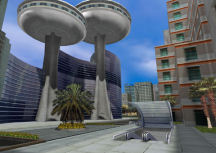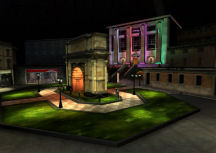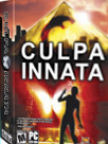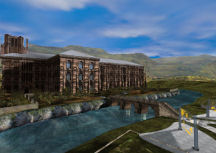Not since Kate Walker of Syberia have we had such
an engaging protagonist as we do with Phoenix Wallis of Culpa Innata.
Wallis is a young woman who is a peace officer in a futuristic system of
the year 2047. As one plays the game, one assists Wallis in investigating
her first major case. In addition we are given a glimpse into the inner
growth of Wallis as she questions values and makes determinations that are
not necessarily in her best career interest. In turn naïve, hardworking,
stubborn, courageous, sensitive and innovative, Wallis finds that there
may be more to life than she ever realized, and that reasons may exist for
her secret reluctance to fit into the role expected of her by society. The
story line is excellent and compelling. This is an immense game, and at
least on the first play, one is not eager to have it completed.
“All of you here are blessed with perfectly
selfish genes!” – Culpa Innata
The world of the future involving a “big brother”
mentality is not a novel idea in either literature or gaming, but the
treatment of it in this game is thorough and appealing. Countries with
significant economic resources have united in a World Union, where
citizens of value and high social standing are those who are smartest,
wealthiest and most healthy. Selfish genes are lauded, and altruism is
considered a weakness. Sex is entertainment, there are no marriages, and
children are considered an investment raised in development centers by the
Union rather than in biological families. Disease and crime have been
eliminated, in contrast to the territories that are not part of the World
Union. The other territories consist of the Rogue States that operate much
as our world does today, and the “Unexploited” areas, where genetic makeup
of the citizens is so poor as to not be in any way compatible with the
Union. (Unless the unexploited areas happen to have natural resources that
would benefit the Union, in which case they fall under the jurisdiction of
Union military forces.)
Huge numbers of people living in the Rogue States want
to pursue a better life in the World Union, and apply to attend the
immigration academies. One of Wallis’ primary duties is screening these
academy graduates for subversive personalities prior to their becoming
World Union citizens.
A crime (virtually unheard of in this society) has been
committed against a World Union citizen who traveled to the Rogue States.
The investigation of the death of that citizen falls to Wallis, and is
where we begin our playing of the game.
“A GPSN officer is responsible for enforcing peace
and order in the World Union and its territories.” – Culpa Innata
In the World Union, all citizens are required to wear a
personal assistant (PA) which connects them to the Global Peace and
Security Network (GPSN). This handy device includes a navigational map,
inventory, a diary, and of course acts to make Wallis instantly accessible
to her boss or associates. As play begins, Wallis’ PA is missing and must
be located. Searching for the PA acts as a sort of tutorial in this 3D
game. We search the cavernous workplace using a third person perspective,
and there is background information on the world we find ourselves in to
be discovered.
As one might expect in a murder investigation, much of
what follows involves speaking with associates of the murder victim to
ascertain who might have wanted to kill him and why the crime occurred. I
happen to very much enjoy a lot of dialog in the games I play, but be
forewarned if this is your nemesis. Some of the irrelevant dialog can be
whittled down if you wish, but the trick is in knowing which conversation
paths to pursue, and in what manner the questioning should be conducted.
Certain dialog sequences may unlock additional people to question.
(Obscenities are sprinkled throughout, as well as references to mature
themes.)
World Union rules mandate that citizens cannot have too
much of their time taken up by questioning, so your conversation will
sometimes be cut off before you reach all the objective facts, requiring
return visits. Your daily work hours are also limited, and it will be
necessary to choose which individual or location can best further your
investigation. Despite the restriction, you don’t experience any anxiety
in taking time to enjoy the game at your own pace, and in fact can direct
Wallis to exercise at the health club, change outfits, or go out to
dinner. Such things have no impact on the story line, but (like some of
the dialogs that aren't pertinent to the investigation) are entertaining
to pursue.
“GPSN Peace officers are required to report any
failure or deficiency in any bodily functions to their nearest GPSN Health
Center” -- Culpa Innata
At times the dialog shows continuity errors, and the
subtitles have a few typographical errors, but these are minor and should
not greatly detract from the game. Amazing, actually, that more continuity
errors don’t occur, given the almost absolute freedom you have in choosing
where you wish to go and with whom you wish to speak!
Besides the dialog manipulation (which can function as a
puzzle), there are a few inventory puzzles -- but the balance of the
puzzles involves logic or object manipulation. The puzzles are generally
fresh and new, and not too difficult, although an option for an instant
solution might be a welcome addition. Image reconstruction, pattern
analysis and the like on Wallis’ computer bring depth to the investigation
and serve to draw you more deeply into the case at hand. Occasionally I
didn’t see the logic in a puzzle, but trial and error would solve it
nonetheless. There are no timed or action sequences, no mazes, and no
sliders. Your character cannot die.
Very handy indeed is the diary function in the PA. The
events of the day are noted, and if a particular avenue of exploration has
not been pursued and is available, it will appear in red print. In other
words, if you’re stuck as to what needs to be done to further game play,
the diary usually (but not always) gives a hint to what else can be
accomplished. If you don’t pursue this avenue of investigation, it may
disappear as a possibility, as your investigation takes a different path
towards a solution. The nonlinearity of the game also means that you can
finish it without opening some areas of exploration or meeting all the
possible characters.
While the nonlinearity of the game makes it essentially
replayable, it is also unfortunate that you may never realize that there
is a second theme running through the game. That theme is a great part of
the beauty of this game, and it is most unfortunate if you miss it, as it
transcends the obvious theme of solving the murder.
“Well, well Phoenix! After all these years of
boredom and self-pity about your career choice, you landed the opportunity
of your life.” – Culpa Innata
Travel to locations is made easy by the navigation map
in your PA. When no further investigation is to be done at a certain
place, it is grayed out on the map. Businesses conform to appropriate
hours – shops are closed in the evening, and nightclubs are closed during
the day. Some individuals are busy and can’t be spoken to at certain
times. It is important, though, for Wallis to also venture out the door of
some of the locations and walk around, or valuable clues may be missed.
Walking around the city is interesting, especially at night when the use
of light and shadow make it an enjoyable sight.
The graphics range from the pretty night effects to a
rather average daytime view. Although the colors are realistic, the art of
the background landscape is not what it could be and at times appears
distorted. The animations are also somewhat awkward. In sharp contrast
are the excellent facial close-ups of the characters, with exceptionally
good lip synching.
The camera angles can be irritating, making it harder to
move your character. After a load screen, Wallis was often found facing in
the opposite direction, and I would then unintentionally move her right
back to the prior screen. In addition, sometimes there are arrows to move
the character, and sometimes there aren’t. Sometimes the arrows don’t
function, and you click around the screen attempting to move. Sometimes a
double click would make the character run, and sometimes it wouldn’t.
“Handwriting? How weird! Where would he even find
a pencil?” – Culpa Innata
The musical score is mostly very pleasing, with a
powerful theme song that I listened to many, many times. Music changes as
the environment changes, and serves to embrace the story line. Here and
there I was reminded of the score from the Gabriel Knight games. I wish
all of it had been like that, but on occasion there were strange elements
to the music, like knocking and grunts, that were distracting.
The voice acting talent ranges from the excellent --
Wallis, her boss Chief Morssen, her best friend Alessandra Pescara and a
few other minor characters -- to the adequate (and even less than
adequate) voices of others. Some characters appear to be reading their
lines without inflection, and stop in the middle of the sentence until the
subtitles are reflected on the screen.
There is a curious lack of ambient sound, although
Wallis’ footsteps can be heard too much.
The first time I played the game, I played unpatched and
had no problem with crashes or glitches. The second and third times I
played I did have an occasional crash. It would be wise to save often,
which you can do anywhere in the game outside of cut scenes.
There are ample saves -- I had
forty saves without overwriting.
The Momentum team has been exemplary in making patches available
and offering their personal assistance to those who have problems in this
regard, and they should be appreciated for their attention to their game
players.
I mentioned previously a second theme in the game that
you may or may not unlock. I found this second theme to be much more
intriguing than the basic premise of investigating a murder, and was
rather irritated that investigation in this direction led to a huge number
of unanswered questions. A great big teaser for a sequel I would imagine,
and all will be forgiven if it is forthcoming.
A very important facet of reviewing a game to me is the
answering of one question. Is it fun to play? This game is a delight to
play, and in my opinion one of the best adventure offerings of the year.
Summary:
Third person
point and click adventure game.
A strong story
line with a huge amount of dialog, many characters and locations. Easy map
navigation.
A lengthy game
which is replayable to take different game paths.
No action or
timed sequences, and you cannot die.
Puzzles are
dialog, logic and inventory based. There are no mazes or sliders.
Graphics and
controls are adequate; lip synching is excellent.
Overall, an
immensely fun game to play.
Grade A
November 2007
design copyright ©
2007
GameBoomers
Group




